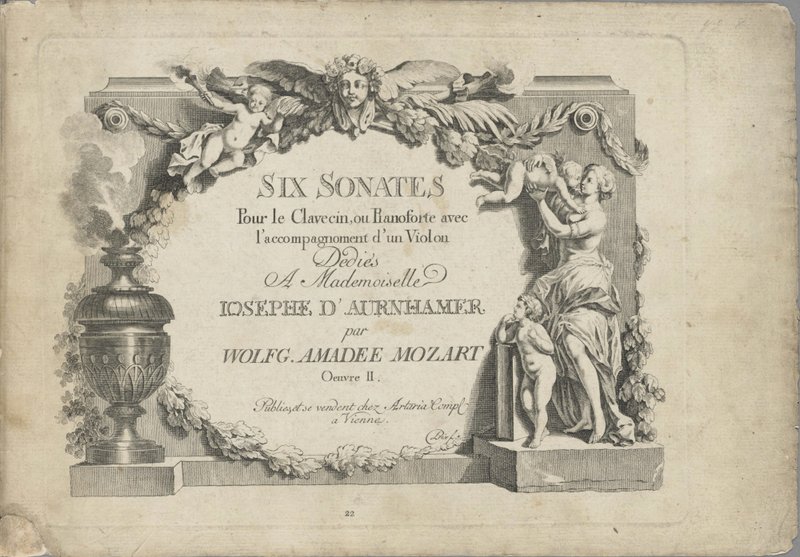Commentary
At the end of 1781, the Viennese publisher Artaria issued an edition of six Mozart sonatas for violin and piano: K. 376, K. 296, and K. 377–380. The set, published as “op. 2,” was first advertised in the Wiener Zeitung on Sat, 8 Dec 1781 (Dokumente, 175–7; Haberkamp 1986, 173–76).

Artaria’s advertisement, Wiener Zeitung, no. 98, Sat, 8 Dec 1781, Anhang, [15]
(ANNO)

Title page of Artaria’s edition of Mozart’s op. 2
(IMSLP)
Little is known about the early reception and distribution of this set. Mozart wrote to his father on 24 Nov 1781 (two weeks before Artaria’s advertisement): “Nun sind meine Sonaten heraus gekommen, die ich ihnen mit nächster gelegenheit übermach werde” (“Now my sonatas have been published, which I will send to you at the next opportunity”; Briefe, iii/1771); on 15 Dec 1781 (one week after the advertisement) he wrote that he had, indeed, sent them (Briefe, iii/179). On 29 Apr 1782, Leopold Mozart wrote to Breitkopf in Leipzig: “Mein Sohn ist und bleibt in Wien. bey Artaria sind Clavier Sonaten von ihm herausgekommen (“My son is in Vienna and remaining there. Keyboard sonatas by him have been published by Artaria”; Briefe, iii/205). In calling these simply “keyboard sonatas,” Leopold took his cue from Artaria’s title page, treating the accompanying violin as secondary, and not worth mentioning.
The earliest known review of opus 2 makes clear, however, that these sonatas were something quite new, in which violin and keyboard were equal partners. This review has long been known from its publication in Carl Friedrich Cramer’s Magazin der Musik under the date 4 Apr 1783 (the review is transcribed in Dokumente, 190).

It seems to have escaped notice up to now that the same review appeared nearly a year earlier in the Reichs-Postreuter on 29 Apr 1782—the same date, as it happens, as Leopold’s letter, and a mere five months after the edition was first advertised in Vienna. The Postreuter was published in Altona, at that time a separate town, today part of Hamburg. Thus Mozart’s sonatas had received a highly favorable review in that faraway city quite soon after their publication. (For more on the history of Mozart reception in Hamburg, see our entry for 19 Feb 1792, on the memorial concert for him in that city.)
The review of Mozart’s op. 2 in the Postreuter is the last of five similarly brief evaluations of works by other composers (titles are given as they appear in the Postreuter):
- Johann August Just (ca. 1750–1791). Six Trios pour le Clavecin ou Piano Forte avec Accompagnement d’une Flute Traversiere, Violon, Viola & Violoncelle obligé … Oeuvre XIII. ches J. J. Hummel à Berlin & Amsterdam.
Hummel’s edition of Just’s op. 13 was announced in the Amsterdamsche courant on 3 Nov 1781, and it appeared around 4 Jun 1782 (Johanssen 1972, i/39). See the RISM listing for the edition here. The confusing title, which seems to imply a “trio” for keyboard and four accompanying instruments, is clarified in Bland’s edition (IMSLP): three trios have flute with keyboard and cello, two have violin, and one has viola. - Johann Friedrich Gottlieb Beckmann (1737–1792), Six Sonates pour le Clavecin ou le Piano Forte accompagnees d’un Violon & Violoncelle … Oeuvre Troisieme ches J. J. Hummel, à Berlin & Amsterdam.
Hummel’s edition of Beckman’s op. 3 was advertised in Berlinische Nachrichten on 8 Sep 1781 as slated to appear on 25 Dec 1781 (Johanssen 1972, i/39). See the RISM listing for the edition here and a digitized exemplar here. - Johann Franz Xaver Sterkel (1750–1817), Trois Sonates pour le Clavecin avec l’accompagnement d’un Violon & Violoncelle … Oeuvre VII, à Francfort ches W. N. Haueisen …
The sonatas are Sterkel Werkverzeichnis (StWV) 169 (Fischer 2014, 295–97), in the keys of D, C, and G. See the RISM record for the edition here, and a digitized exemplar here. According to Fischer, the sonatas date from 1779. - Joseph Haydn, Stabat mater (Hob XX:bis): Des Herrn Joseph Haydn Passionsmusik des Stabatt [sic] Mater, mit einer deutschen Parodie, in einem Claviermäßigen Auszug herausgegeben von Johann Adam Hiller. Leipzig im Schwickertschen Verlage.
For Hiller’s keyboard reduction of Haydn’s Stabat mater with German text, see the RISM record here.
The same reviews of the sets by Just, Beckmann, Sterkel, and Mozart appear in the same order in Magazin der Musik (1783, 483–85). In the Postreuter, the sentence immediately following the review of Mozart’s sonatas (given in blue above) notes that all five works (including the Haydn) are available from the Musikalische Niederlage in Hamburg, the music dealership of Johann Christoph Westphal (1727–1799). Magazin der Musik was established at the end of 1782 as a joint project of Westphal and Carl Friedrich Cramer, who solicited music, reviews, and miscellaneous writings about music and musical life from all over Europe (see Cramer 1782).
In the Postreuter, the reviews are not attributed; in Magazin der Musik, they carry the attribution “N. N.” (“Nomen nescio”), “I do not know the name.” The author remains unknown. Because the reviews appeared in Hamburg and all the works are said to have been available at Westphal’s Musikalische Niederlage, it is tempting to think that the reviews are by a Hamburg author. But this is not necessarily so, as Westphal and Cramer explicitly solicited reviews from anywhere, and these reviews may have been sent in anonymously. However, the publication of the review in the Postreuter on 29 Apr 1782 along with the notice that all five works (including op. 2) were available from Westphal confirms that Mozart’s sonatas had reached Hamburg by that date. The set also certainly corresponds to the entry in Westphal’s catalog for 1782, “[Mozart] 6 [Clavier Sonaten] mit obl. Violin, Op. 2 Wien” (“[Mozart] 6 [keyboard sonatas] with obbligato violin, op. 2 Vienna”, Westphal 1782, 58), even though that entry appears under the general heading “Clavier-Trios.”

